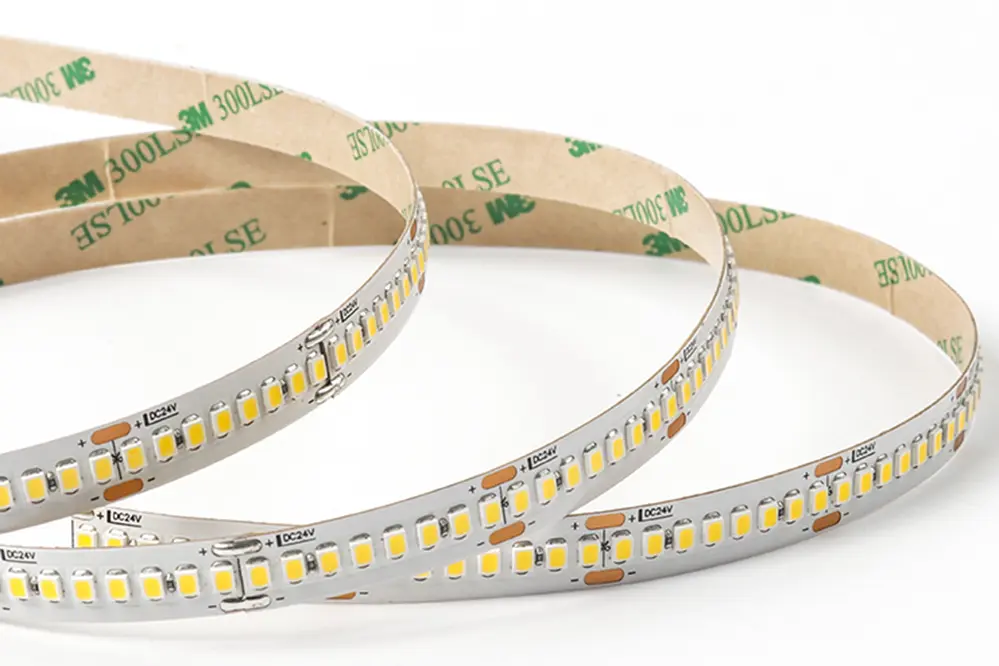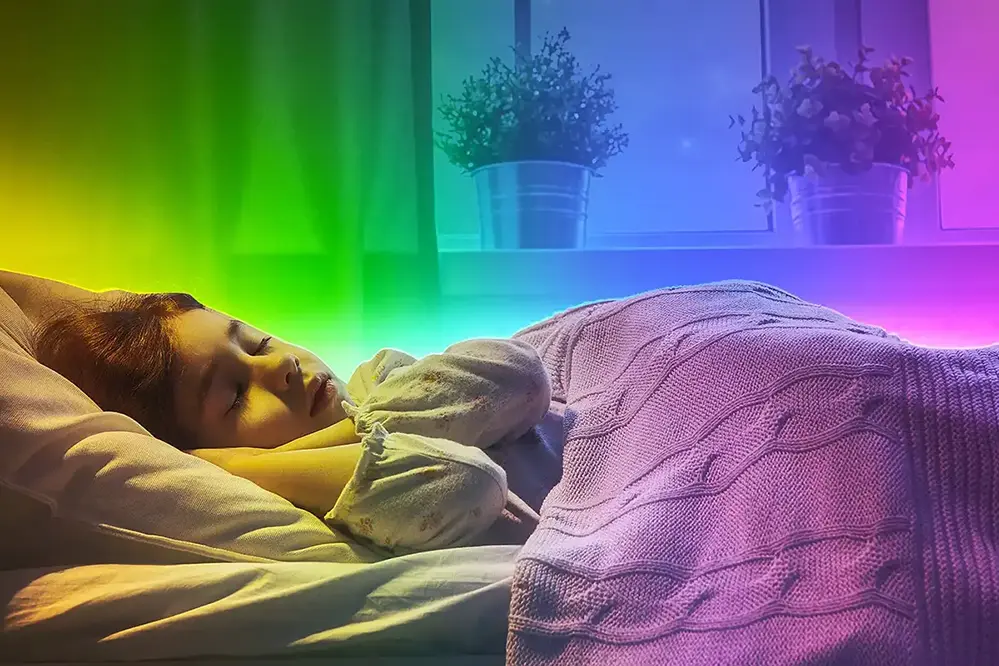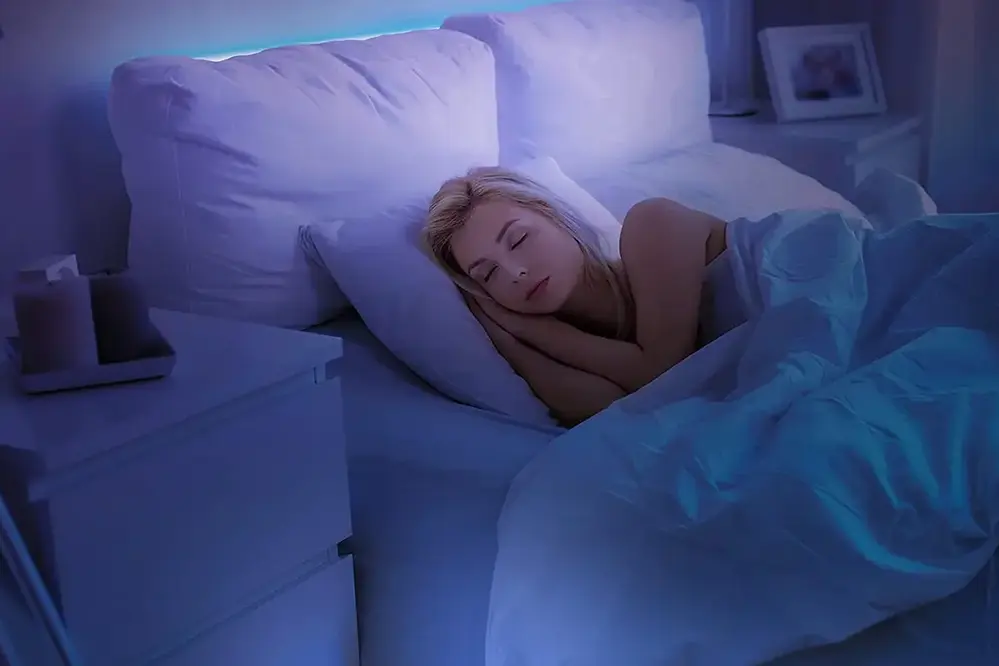Are you wondering whether it’s safe to leave your LED strip lights on all night? Look no further! As an expert in lighting and safety, I have the answers you’re looking for. In this blog post, we’ll explore the safety aspects of leaving LED strip lights on overnight and provide you with some valuable tips to ensure a worry-free experience.
Leaving LED strip lights on all night is generally safe, but it’s important to follow some safety precautions. Make sure to choose high-quality LED strips that are designed for continuous use, avoid overloading electrical circuits, and keep an eye on the temperature. By taking these measures, you can enjoy the ambiance and convenience of LED strip lights without any worries.
But that’s not all! In the following sections, we’ll delve deeper into the safety considerations of leaving LED strip lights on overnight. We’ll discuss the potential risks, the impact on energy consumption, and provide you with expert tips to optimize the lifespan of your LED strips. So, keep reading to ensure you have all the information you need for a safe and enjoyable lighting experience.
Understanding LED Strip Light Safety

LED strip lights, embodying solid-state lighting technology, are inherently more robust and durable compared to their incandescent or fluorescent counterparts. However, the continuous operation of these diodes, even with their low heat emission and energy-efficient characteristics, does not absolve them of all potential hazards. Proper installation, quality of product, and adherence to manufacturer guidelines are paramount to ensure safe, long-term usage of these lighting elements throughout nocturnal hours.
The specific design and engineering of LED strip lights typically incorporate features that mitigate overheating risks, an essential consideration for devices that may operate continuously. Nonetheless, the ambient environment and the surface to which the strips are affixed can influence heat dissipation, thus vigilance, and periodic inspection of the setup is advisable to preempt any compromise in safety or functionality.
Fire Risk Analysis
LED strip lights are low on energy consumption and emit less heat than traditional bulbs, reducing the potential fire hazard.
LED strip lights utilize up to 75% less energy than incandescent lighting, which can mitigate their propensity to overheat.
However, the risk of fire cannot be overlooked. Poor-quality strips, or those incorrectly installed, can overheat, damage surfaces, or even spark—especially when left on for extended periods.
Faulty wiring or overloaded circuits also contribute to fire risks. Selecting high-quality LED strip lights and ensuring professional installation is crucial for preventing such hazards.
Electrical Hazards Consideration
Leaving LED strip lights on overnight requires assessing their electrical safety to prevent hazards.
- Verify the quality and certification of the LED strip lights, ensuring compliances, such as UL listing.
- Inspect for proper insulation and integrity of wiring, especially if the LED strips have been cut or modified.
- Avoid overloading power outlets with multiple lighting elements or adapters.
- Ensure that the LED strips are compatible with the power supply units and any dimmers or controllers used.
- Keep the LED strips and power supplies away from flammable materials and ensure adequate air circulation for cooling.
LED strips should operate within their designed electrical parameters to eliminate risks.
An uninterrupted operation increases the need for durable and reliable components to prevent electrical malfunctions.
Assessing Effect on Sleep Quality

The question of whether to leave LED strip lights on through the night touches on more than just electrical safety; it intersects with considerations of sleep hygiene. Exposure to artificial lighting before bedtime can disrupt the body’s circadian rhythms, which govern sleep-wake cycles. Hence, choosing LEDs with a warm color temperature and dimmable features can be instrumental in mitigating potential disturbances to one’s sleep environment.
Utilizing LEDs with control systems that mimic natural light progression could foster a healthy sleep cycle by gradually dimming as bedtime approaches. Ensuring that any nocturnal illumination is diffused and strategically placed will be essential in preserving the sanctity of a restful night’s slumber.
Impact of Light on Circadian Rhythms
Light is a potent regulator of the circadian system.
The retina in the human eye absorbs light and relays that information to the suprachiasmatic nucleus (SCN), the brain’s master clock located in the hypothalamus. This neural pathway enables light to exert a profound influence on circadian rhythms, which cycle roughly on a 24-hour period. Consequently, any substantial light exposure, particularly at night, can disrupt these biological clocks.
Artificial light can significantly alter circadian regulation.
The effects of artificial light range from – but not limited to – delayed sleep onset and reduced sleep quality. If the light is of a blue-rich spectrum, commonly found in LED strip lights, the impact on melatonin secretion, a hormone critical for sleep initiation, is remarkably pronounced.
Persistent exposure to light impacts health and wellbeing.
The long-term ramifications of disrupting circadian rhythms include increased susceptibility to various health disorders, including sleep disorders, metabolic syndrome, and even mood disturbances. As we progress through 2023, the importance of understanding and managing light exposure becomes ever more critical for maintaining robust circadian health.
Choosing the Right Light Color for Sleep
The spectrum of light plays a pivotal role in regulating our sleep-wake cycle.
- Red or Amber: Colours with longer wavelengths and lower energy which do not significantly disrupt melatonin production.
- Soft White: A more neutral option that is less stimulating than cooler hues.
- Dimmable Warm White: Allows for reduced light intensity, which is conducive to getting ready for sleep.
Non-disruptive hues are critical to preserving natural circadian rhythms.
Minimizing exposure to blue light at bedtime can facilitate a healthier sleep pattern.
Energy Consumption Considerations

When contemplating overnight operation of LED strip lights, energy consumption is an aspect that can’t be overlooked. LED technology is acclaimed for its energy efficiency, meaning that it consumes less electricity compared to traditional lighting solutions. This inherent frugality makes LED strip lights an appealing choice for those who prioritize both ecological and economical aspects of energy use.
However, it’s essential to recognize that “less” does not mean “none.” Over time, even LED strips left on continuously can add up to significant energy usage. To mitigate this, selecting LEDs with a lower wattage or integrating a timer that will turn off the lights automatically can support energy conservation efforts. Ultimately, the cumulative energy consumption should be a contributing factor in deciding whether to keep LED strip lights on throughout the night.
Cost Implications of All-Night Use
Continual overnight use of LED strip lights equates to increased electric bills. While LEDs are economical, they’re not free to operate.
If left unchecked, the cumulative cost of nightly LED usage can become noticeable over extended periods, subtly inflating your monthly expenses.
Assessing the wattage and calculating the expected usage costs empowers users to make informed decisions about their lighting practices.
Implementing energy-saving strategies such as dimmers or motion sensors for LED strips may result in considerable cost savings over time.
Hence, while LED strips are an efficient choice, mindful usage is key to optimizing cost-effectiveness.
LED Lifespan and Efficiency
LED strip lights are distinguished by their longevity and efficiency compared to traditional lighting options. When properly maintained, they can last for thousands of hours, significantly outperforming incandescent and fluorescent counterparts.
The efficiency of LEDs is largely attributed to their lower heat output. This intrinsic quality results in less energy waste and extends their operational life.
However, continuous operation, such as leaving the strips on all night, can still have a detrimental impact. Consistently running LEDs at full brightness, without periods of rest, can lead to premature degradation of the diodes, compromising their longevity and luminous efficacy over time.
To maintain the inherent efficiency and longevity of LED strip lights, it is advisable to adopt practices that mitigate continuous use. Employing dimmer settings or utilizing a “sleep” mode, where the lights operate at significantly reduced brightness, not only conserves energy but also decreases the thermal stress on the lighting system. This approach can prolong the operational lifespan of LED strip lights, ensuring they remain a performance-optimized and economically viable lighting solution.
Practical Tips for Overnight Use
When considering the use of LED strip lights throughout the night, it is imperative to address safety and efficiency to avoid potential hazards and ensure longevity. Begin by assessing the quality of the LED strip lights; reputable brands often produce more reliable and longer-lasting products. Always ensure that the strips and their power supplies are correctly installed, avoiding any contact with flammable materials. Using a timer or smart lighting system to control the lights can greatly enhance safety, automatically turning them off after a set period to prevent overheating. Moreover, selecting LEDs with a lower lumen output or setting them to a dimmed mode can significantly reduce the operational temperature and energy consumption, further minimizing risks. Regularly inspecting the strips for any signs of damage, such as exposed wires or flickering, is also crucial to maintain a safe environment if they are to be used overnight.
Optimal Placement for Safety
When installing LED strip lights, consider their proximity to flammable materials. The distance should be sufficient to mitigate any risk of heat transfer leading to potential ignition.
Careful consideration should be given to the mounting surface, which should be inherently non-flammable and stable. Avoid draping over fabric or wedging between tightly packed items; such actions elevate the risk of overheating and consequent hazards. Secure mounting ensures the strips cannot be displaced or interfere with other objects, further promoting a safer environment for overnight operation.
Additionally, ensure ample air circulation around the LED strip lights to assist in heat dissipation. Enclosed spaces, while aesthetically pleasing, can trap heat and increase operational temperatures, heightening the risk of overheating and reducing the lifespan of the LEDs.
In summary, select installation sites that are free from direct contact with fabrics and provide stable, temperature-resistant surfaces. Furthermore, optimize for unobstructed air movement to maintain lower operating temperatures. These precautions will not only extend the longevity of the LED strips but also reduce the potential for accidents that arise from prolonged use. Implementing these best practices can provide peace of mind when leaving LED strip lights on through the night.
Using Timers and Dimmers for Better Control
Incorporating timers into LED strip lighting systems can create an automated schedule, promoting energy efficiency and safety. Timers allow for pre-set on and off periods, aligning with user needs and preventing unnecessary usage overnight.
Advanced dimming capabilities also offer a nuanced approach to lighting preferences. Dimming can soften the brightness to a comfortable level for sleeping environments.
Utilizing timers with dimmers can significantly enhance the user experience, allowing for adjustments to brightness at specific times, creating a tailor-made ambiance. This combination reduces power consumption while also mitigating any potential risks associated with prolonged LED strip light operation.
By integrating both timers and dimmers, users gain unparalleled control over their lighting environment, adjusting intensity to suit various scenarios while maintaining vigilance against the dangers of continuous use. With such systems in place, the potential for heat build-up is lessened, as is the draw on power resources—contributing to a secure and energy-conscious lighting solution.
FAQs
Do LED strip lights overheat?
LED strip lights are generally designed to be very efficient and produce minimal heat. This is because LEDs themselves produce very little heat compared to traditional lighting sources. However, it is still possible for LED strip lights to overheat if they are not used or installed properly.
To prevent overheating, it is important to ensure proper ventilation around the LED strip lights. This means avoiding blocking the lights with objects or installing them in enclosed spaces where heat can build up. Additionally, using LED strip lights with a lower wattage and using an appropriate power supply can also help to reduce the risk of overheating.
Another factor that can contribute to overheating is overloading the LED strip lights. It is important to follow the manufacturer’s guidelines for the maximum load capacity of the lights and not exceed it. Overloading the lights can cause them to generate more heat than they are designed to handle, leading to potential overheating issues.
In some cases, using LED strip lights for prolonged periods of time can also increase the chances of overheating. It is recommended to give the lights a break after a certain period of continuous use to allow them to cool down. This can help to prevent any potential overheating issues and extend the lifespan of the lights.
Overall, while LED strip lights are generally designed to be safe and efficient, it is important to take proper precautions to prevent overheating. By ensuring proper ventilation, avoiding overloading the lights, and giving them breaks when needed, you can help to minimize the risk of overheating and ensure the longevity of your LED strip lights.
How long can I leave LED strip lights on?
LED strip lights can be left on for extended periods of time without any issues. LED technology is known for its energy efficiency and long lifespan, making it safe to keep them illuminated for hours on end.
However, it is important to follow some guidelines to ensure optimal performance and to maintain the longevity of your LED strip lights. Firstly, make sure the lights are properly installed and have good ventilation to prevent heat build-up. This will help to prevent any potential overheating issues.
Secondly, consider the manufacturer’s recommendations for the maximum continuous usage time. While most LED strip lights can be left on for 24 hours a day, some manufacturers may have specific recommendations for their products. It’s always a good idea to check the product specifications or contact the manufacturer for any specific guidance.
In general, LED strip lights are designed to have a long lifespan and can last for many years with regular use. As long as you have chosen high-quality LED strip lights and have followed the necessary precautions, you should not have any problems leaving them on for an extended period. Just remember to turn them off when not in use to conserve energy and prolong their lifespan.
In summary, LED strip lights can be left on for a long time without any issues, thanks to their energy efficiency and long lifespan. Ensure proper installation and ventilation, follow manufacturer recommendations, and be mindful of turning them off when not needed to maintain optimal performance and longevity.
Should LED strip lights be turned off overnight?
LED strip lights can be turned off overnight without any negative effects. In fact, it is generally recommended to turn them off when not in use to save energy and extend the lifespan of the lights. LED strip lights are designed to be turned on and off frequently without any impact on their performance or longevity.
Turning off the LED strip lights overnight can help reduce energy consumption and lower your electricity bill. Since LEDs are highly energy-efficient, they consume very little power when compared to other types of lighting. By turning them off when you’re not using them, you can save even more energy and contribute to a greener environment.
Additionally, turning off the LED strip lights can help prevent any potential fire hazards. Even though LED strip lights generate very little heat, it is always a good safety practice to turn off electrical devices when they are not being monitored or supervised.
In conclusion, it is perfectly safe and beneficial to turn off LED strip lights overnight. Doing so can help save energy, prolong their lifespan, and minimize any potential fire risks. So don’t hesitate to switch them off when they are not needed to enjoy their benefits for a longer time.
Do LED strip lights consume much power when left on?
LED strip lights are known for their energy efficiency, and when left on, they consume very little power compared to traditional lighting options. This is due to the use of Light Emitting Diodes (LEDs), which are highly efficient at converting electricity into light.
LED strip lights are designed to emit a high amount of light using a minimal amount of power. The power consumption of LED strip lights is typically measured in watts per meter (W/m). In general, LED strip lights consume between 4 to 14 watts per meter, depending on the brightness level and color temperature.
Compared to other types of lighting, such as incandescent or fluorescent bulbs, LED strip lights can consume up to 80% less power when left on. This energy efficiency makes LED strip lights an ideal choice for long-term use, as they can significantly reduce overall electricity consumption and lower utility bills.
Furthermore, LED strip lights have a longer lifespan than traditional lighting options, which means they can be left on for extended periods without the need for frequent replacements. This not only saves on energy usage but also reduces maintenance and replacement costs.
In summary, LED strip lights consume very little power when left on due to their energy-efficient design. With their low wattage consumption and long lifespan, LED strip lights are an excellent choice for those looking to reduce energy consumption and save on electricity costs.
Conclusion
When considering LED strip lights for extended use, such as overnight, one must prioritize products that are backed by reputable quality certifications. Overarching safety concerns must be addressed, such as the potential for overheating, to ensure that when lights remain on, they do so within a secure operational threshold. Moreover, adherence to stringent standards of construction ensures the mitigation of electrical risks associated with improper components or design.
The verdict on leaving LED strips on overnight is mixed. Implement proper installation and position with care. Optimize your setup with timers and dimmers for a safer experience. Always consult the latest guidelines for electrical safety and efficiency.
If you’re in need of high-quality LED strip lights and LED neon strips, I highly recommend reaching out to Unitop, a professional Chinese manufacturer. With their expertise and commitment to producing top-notch lighting solutions, you can trust that their products will meet your needs for both safety and performance. Don’t hesitate to contact Unitop for all your LED strip light requirements and enjoy the benefits of reliable and efficient lighting solutions.





